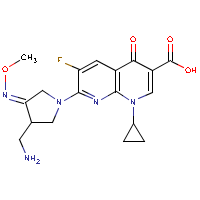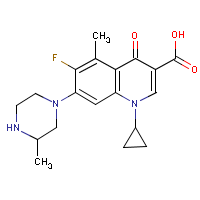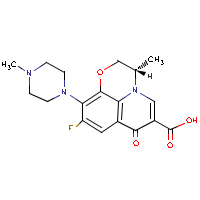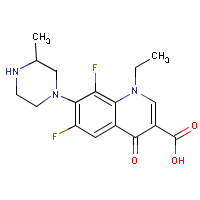|
Return to Phototoxic Pesticides
Abstracts
KEYWORDS:
photocarcinogenic, photocarcinogenicity
photoclastogenic
photocytotoxic
photogenotoxic
photohemolytic
photomutagenic, photomutagenicity
phototoxic, phototoxicity
| |
|
|
|
| |
|
|
|
Bay
Y3118
Ciprofloxacin
Clinafloxacin
Enoxacin
Fleroxacin |
Gemifloxacin
Grepafloxacin
Levofloxacin
Lomefloxacin |
Moxifloxacin
Norfloxacin
Ofloxacin
Pefloxacin
Sitafloxacin |
Sparfloxacin
Temafloxacin
Tosufloxacin
Trovafloxacin |
| Name: |
Gemifloxacin |
| CAS No. |
175463-14-6
(and 204519-64-2) |
| Formula: |
C18-H20-F-N5-O4
|
| Structure: |
 |
| Other Names: |
LB-20304
SB 265805 |
| Class |
Fluoroquinolone |
Effects
(some, not all) |
•
Photoclastogenic
• Phototoxic |
| Use: |
Antibiotic used to treat infections such
as pneumonia (lung infections) or bronchitis (infection of
the tubes moving air in and out of the lungs) caused by certain
bacteria. |
Gemifloxacin
Abstracts:
The photochemical clastogenic
potential of 12 quinolone antibacterial agents with or without
light irradiation was assessed by an in vitro chromosomal aberration
test using cultured CHL cells. Exposure to all test compounds,
except for DK-507k, increased the incidence of cells with structural
aberrations excluding gap (TA) following light irradiation. Test
compounds used in the present study under light irradiation were
divided into three groups based on their ED50 values, doses inducing
chromosomal aberrations in 50% of cells. The
first group with ED50 values below 30 g/ml includes sparfloxacin
(SPFX), clinafloxacin (CLFX), gemifloxacin
(GMFX), lomefloxacin (LFLX), sitafloxacin (STFX), grepafloxacin
(GPFX) and fleroxacin (FLRX); the second group with ED50 values
of 100 g/ml, enoxacin (ENX) and levofloxacin (LVFX);
the third group with little or no potency, moxifloxacin (MFLX),
trovafloxacin (TVFX) and DK-507k. The photochemical
clastogenicity of these compounds correlates well with their reported
in vivo phototoxic potentials. In
the chemical structure and clastogenicity relationships, substitution
of a methoxy group at the C-8 position in the quinolone nucleus
was confirmed to reduce not only photochemical clastogenicity,
but also the clastogenic potential of quinolone antibacterial
agents.
Ref: In vitro photochemical clastogenicity
of quinolone antibacterial agents studied by a chromosomal aberration
test with light irradiation. By Satoru Itoh et al. Mutation Research/Genetic
Toxicology and Environmental Mutagenesis Volume 517, Issues 1-2
, 27 May 2002, Pages 113-121.
| Name: |
Grepafloxacin |
| CAS No. |
119914-60-2
|
| Formula: |
C19-H22-F-N3-O3 |
| Structure: |
 |
| Other Names |
CCRIS
7284
GPFX |
| Class |
Fluoroquinolone |
Effects
(some, not all) |
•
Photogenotoxic
•
Photoclastogenic
• Phototoxic
• Can prolong the QT interval to cause lethal ventricular
arrhythmias |
| Use: |
Antibacterial
Drug /
Therapeutic Agent
•
Withdrawn from worldwide markets due to cardiovascular
effects |
Grepafloxacin
Abstracts:
Fluoroquinolone development from 1985 to the present was reviewed.
Severe drug adverse events were noted for enoxacin, pefloxacin
and fleroxacin, which were phototoxic. Temafloxacin was associated
with severe hemolytic-uremic syndrome, lomefloxacin
caused phototoxicity and central nervous system (CNS) effects,
and sparfloxacin was associated with phototoxicity and
QTc prolongation. Tosufloxacin caused severe thrombocytopenia
and nephritis, and hepatotoxicity was reported for trovafloxacin.
Grepafloxacin was withdrawn due to cardiovascular
effects, and clinafloxacin was associated with phototoxicity
and hypoglycaemia. The structure of the quinolones directly relates
to both their activity and side-effect profiles. The relationship
among specific substituents attached to the quinolone nucleus
are clarified. The incidence of specific adverse events associated
with individual fluoroquinolones was reviewed in a five-year post-marketing
surveillance (PMS) study in Japan, in which a total adverse drug
reaction (ADR) rate of 1.3% was found for levofloxacin, compared
to total ADR rates of 3.3% for pazufloxacin, 3.6% for tosufloxacin,
4.5% for gatifloxacin and 5.4% for balofloxacin. Gastrointestinal
effects were the most common adverse events for all fluoroquinolones.
Levofloxacin had the lowest rate of CNS effects and skin adverse
events among the agents listed.
Ref: History of quinolones and their side
effects by E Rubinstein. Chemotherapy. 2001;47 Suppl 3:3-8; discussion
44-8.
Clinical trials in patients with community- and hospital-acquired
infections have established that the clinical effectiveness and
safety of fluoroquinolones are similar to -lactam and macrolide
agents. The most common drug-related adverse effects (AEs) with
fluoroquinolone therapy involve the gastrointestinal troct and
central nervous system and are usually transient and mild to moderate
in severity. However, serious toxic reactions have led to the
limited and restrictive use of trovafloxacin in the United States
and the withdrawal of temafloxacin and grepafloxacin
from worldwide markets. In addition, postmarketing spontaneous
AE reports have imposed updates in the precautions and warning
sections of product package inserts of selected fluoroquinolones.
This article reviews the AEs associated with the fluoroquinolones
and compares the safety profiles of ciprofloxacin, levofloxacin,
gatifloxacin, and moxifloxacin.
Ref: Safety and tolerability of fluoroquinolones;
by Kelly A. Sprandel PharmD and Keith A. Rocivold PharmD, FCP,
FCCP. Clinical Cornerstone Volume 5, Supplement 3 , 2003, Pages
S29-S36
Recent reports on the
photochemical carcinogenicity and photochemical genotoxicity of
fluoroquinolone antibacterials led to an increasing awareness
for the need of a standard approach to test for photochemical
genotoxicity. In this study the micronucleus test using V79 cells
was adapted to photogenotoxicity testing. Results of using different
UVA/UVB relationships enabled us to identify a suitable irradiation
regimen for the activation of different kinds of photosensitizers.
Using this regimen, 8-methoxypsoralen and the
fluoroquinolones lomefloxacin, grepafloxacin and Bay Y 3118 were
identified to cause micronuclei and toxicity upon photochemical
activation.
Ref: The application of the micronucleus
test in Chinese hamster V79 cells to detect drug-induced photogenotoxicity.
By B Kersten et al. Mutat Res 1999 Sep 15;445(1):55-71.
The photochemical clastogenic
potential of 12 quinolone antibacterial agents with or without
light irradiation was assessed by an in vitro chromosomal aberration
test using cultured CHL cells. Exposure to all test compounds,
except for DK-507k, increased the incidence of cells with structural
aberrations excluding gap (TA) following light irradiation. Test
compounds used in the present study under light irradiation were
divided into three groups based on their ED50 values, doses inducing
chromosomal aberrations in 50% of cells. The
first group with ED50 values below 30 g/ml includes sparfloxacin
(SPFX), clinafloxacin (CLFX), gemifloxacin (GMFX), lomefloxacin
(LFLX), sitafloxacin (STFX), grepafloxacin
(GPFX) and fleroxacin (FLRX); the second group with ED50
values of 100 g/ml, enoxacin (ENX) and levofloxacin (LVFX);
the third group with little or no potency, moxifloxacin (MFLX),
trovafloxacin (TVFX) and DK-507k. The photochemical
clastogenicity of these compounds correlates well with their reported
in vivo phototoxic potentials. In
the chemical structure and clastogenicity relationships, substitution
of a methoxy group at the C-8 position in the quinolone nucleus
was confirmed to reduce not only photochemical clastogenicity,
but also the clastogenic potential of quinolone antibacterial
agents.
Ref: In vitro photochemical clastogenicity
of quinolone antibacterial agents studied by a chromosomal aberration
test with light irradiation. By Satoru Itoh et al. Mutation Research/Genetic
Toxicology and Environmental Mutagenesis Volume 517, Issues 1-2
, 27 May 2002, Pages 113-121.
Grepafloxacin (GPFX),
a newly synthesized antibacterial agent, was administered orally
to pregnant Std:NZW rabbits at daily doses of 20, 40 and 60 mg/kg
during the organogenetic period, and the effects on dams and fetuses
were examined. 1) Dams in the 40 mg/kg or higher dose groups revealed
death, abortion, decreased spontaneous motor
activity, suppression of body weight gain, and decreased food
consumption. These changes were remarkable in the 60 mg/kg dose
group...
Ref: [Reproductive and developmental toxicity
studies of grepafloxacin (3) -- teratogenicity study in rabbits
by oral administration]. By H Uchiyama et al. Yakuri To Chiryo
1994;22(11):41-8.
Grepafloxacin (GPFX),
a newly synthesized antibacterial agent, was administered orally
to pregnant Slc:SD rats during the
organogenetic period at daily doses of 20, 50 and 150 mg/kg, and
the effects on dams, fetuses and offspring were examined. 1) On
dams, body weight gain was suppressed
in the 150 mg/kg dose group, and food consumption decreased in
the 50 mg/kg and higher dose groups during the gestational period...
Necropsy findings showed enlarged cecum
in the 50 mg/kg and higher dose groups. ... 2) Decreases
in the number of fetal ossified sacrococcygeal vertebrae and in
placental weight in the 150 mg/kg dose group was observed...
Ref: [Reproductive and developmental toxicity
studies of grepafloxacin (2) -- teratogenicity study in rats by
oral administration]. By H Uchiyama et al. Yakuri To Chiryo 1994;22(11):25-39.
Excerpts: Since noncardiovascular
drug-induced prolongation of the QT interval is often associated
with the onset of torsades de pointes resulting in life-threatening
ventricular arrhythmias (De Ponti et al., 2001; Haverkamp et al.,
2000 and Tamargo, 2000), worldwide regulatory authorities have
raised a heightened awareness on the submission of data surrounding
the ventricular repolarization process. Moreover, general nonclinical
testing strategy for delayed ventricular repolarization by human
pharmaceuticals is being discussed in draft stage guideline ICH
S7B for safety pharmacology studies (The ICH Steering Committee,
2002).
In the case of fluoroquinolone antibacterial agents, it has been
reported that sparfloxacin and grepafloxacin
can prolong the QT interval to cause lethal ventricular arrhythmias
(Bertino and Fish, 2000; Demolis et al., 1996; Dupont et
al., 1996 and Owens, 2001), which were withdrawn
in most countries. Recently, gatifloxacin and moxifloxacin
were developed as third generation of fluoroquinolones (Ball,
2000). However, in vitro studies have indicated
that gatifloxacin and moxifloxacin markedly prolonged the action
potential duration of the isolated guinea pig ventricular myocardium
and canine Purkinje fibers (Gintant et al., 2001; Hagiwara
et al., 2001 and Patmore et al., 2000). Also, gatifloxacin
and moxifloxacin inhibited the human cardiac repolarizing K+ current
(Anderson et al., 2001; Bischoff et al., 2000 and Kang et al.,
2001). Clinical studies on the safety pharmacology of gatifloxacin
and moxifloxacin indicated that these fluoroquinolones may induce
QT prolongation and ventricular arrhythmias (Bertino et
al., 2002; Démolis et al., 2000; Iannini and Circiumaru,
2001; Noel et al., 2003; Siepmann and Kirch, 2001 and Von Keutz
and Schlüter, 1999).
Ref: In vivo experimental approach for the
risk assessment of fluoroquinolone antibacterial agents-induced
long QT syndrome; by Katsuyoshi Chiba et al. European Journal
of Pharmacology Volume 486, Issue 2 , 20 February 2004, Pages
189-200.
The new fluoroquinolones (clinafloxacin, gatifloxacin, gemifloxacin,
grepafloxacin, levofloxacin, moxifloxacin, sitafloxacin, sparfloxacin
and trovafloxacin) offer excellent activity against Gram-negative
bacilli and improved Gram-positive activity (e.g. against Streptococcus
pneumoniae and Staphylococcus aureus) over ciprofloxacin... Several
of these agents have either been withdrawn from the market, had
their use severely restricted because of adverse effects (clinafloxacin
because of phototoxicity and hypoglycaemia; grepafloxacin
because of prolongation of the QTc and resultant torsades de pointes;
sparfloxacin because of phototoxicity; and trovafloxacin because
of hepatotoxicity), or were discontinued during developmental
phases. The remaining fluoroquinolones such as gatifloxacin, gemifloxacin,
levofloxacin and moxifloxacin have adverse effect profiles similar
to ciprofloxacin. Extensive post-marketing safety surveillance
data (as are available with ciprofloxacin and levofloxacin) are
required for all new fluoroquinolones before safety can be definitively
established. Drug interactions are limited; however, all fluoroquinolones
interact with metal ion containing drugs (eg. antacids)..
Ref: A critical review of the fluoroquinolones:
focus on respiratory infections; by GG Zhanel et al. Drugs. 2002;62(1):13-59.
http://www.ncbi.nlm.nih.gov/entrez/query.fcgi?cmd=Retrieve&db=pubmed&dopt=Abstract&list_uids=11790155
| Name: |
Levofloxacin |
| CAS No. |
100986-85-4 |
| Formula: |
C18-H20-F-N3-O4
|
| Structure: |
 |
| Other Names |
(S)-Ofloxacin
CCRIS 4074
DR3355
DRG-0129
Elequine
HR 355
Iquix
Ofloxacin S-(-)-form
RWJ 25213-097 |
| Class |
Fluoroquinolone |
Effects
(some, not all) |
•
Photogenotoxic
•
Photoclastogenic
•
Phototoxic
• Diminished
healing during the early stages of fracture repair; may compromise
fracture healing in humans.
|
| Use: |
Drug
/ Therapeutic Agent |
Levofloxacin
Abstracts:
AIM:
To compare two methods of measuring DNA damage induced by photogenotoxicity
of fluoroquinolones (FQ).
METHODS: Lomefloxacin (LFLX), sparfloxacin (SPFX), ciprofloxacin
(CPFX), and levofloxacin (LELX) were
tested by comet assay and photodynamic DNA strand breaking activity
under the different conditions of UVA irradiation.
RESULTS: In comet assay, photogenotoxicity
was evident at SPFX 1 mg/L, LFLX
5 mg/L, and CPFX 5 mg/L, and LELX
10 mg/L. In photodynamic DNA strand-breaking activity,
SPFX and LFLX induced the conversion of the supercoiled form into
the nicked relaxed form at 10-50 micromol/L, while CPFX at 25
micromol/L and LELX at 50 micromol/L.
CONCLUSION: There were good correlations between the two methods
to detect DNA damage induced by phototoxicity of fluoroquinolones.
Photodynamic DNA strand breaking activity was a good method to
detect DNA damage induced by photogenotoxicity
of fluoroquinolones as well as comet assay.
Ref: Compare two methods of measuring DNA
damage induced by photogenotoxicity of fluoroquinolones. By Zhang
T, Li JL, Xin J, Ma XC, Tu ZH. Acta Pharmacol Sin. 2004 Feb;25(2):171-5.
The photochemical clastogenic
potential of 12 quinolone antibacterial agents with or without
light irradiation was assessed by an in vitro chromosomal aberration
test using cultured CHL cells. Exposure to all test compounds,
except for DK-507k, increased the incidence of cells with structural
aberrations excluding gap (TA) following light irradiation. Test
compounds used in the present study under light irradiation were
divided into three groups based on their ED50 values, doses inducing
chromosomal aberrations in 50% of cells. The
first group with ED50 values below 30 g/ml includes sparfloxacin
(SPFX), clinafloxacin (CLFX), gemifloxacin (GMFX), lomefloxacin
(LFLX), sitafloxacin (STFX), grepafloxacin (GPFX) and fleroxacin
(FLRX); the second group with ED50 values of 100 g/ml, enoxacin
(ENX) and levofloxacin (LVFX);
the third group with little or no potency, moxifloxacin (MFLX),
trovafloxacin (TVFX) and DK-507k. The photochemical
clastogenicity of these compounds correlates well with their reported
in vivo phototoxic potentials. In
the chemical structure and clastogenicity relationships, substitution
of a methoxy group at the C-8 position in the quinolone nucleus
was confirmed to reduce not only photochemical clastogenicity,
but also the clastogenic potential of quinolone antibacterial
agents.
Ref: In vitro photochemical clastogenicity
of quinolone antibacterial agents studied by a chromosomal aberration
test with light irradiation. By Satoru Itoh et al. Mutation Research/Genetic
Toxicology and Environmental Mutagenesis Volume 517, Issues 1-2
, 27 May 2002, Pages 113-121.
We previously have shown that experimental fractures exposed
to ciprofloxacin have diminished fracture healing. The purpose
of this study was to assess the effect of levofloxacin and trovafloxacin
on experimental fracture healing to test the hypothesis that diminished
fracture healing is a quinolone class effect. Sixty-one male Wistar
rats were divided into three groups, which received 25 mg/kg of
levofloxacin twice daily for 3 weeks, 35 mg/kg of trovafloxacin
twice daily for 3 weeks, or no treatment, beginning 7 days after
production of closed, nondisplaced, bilateral femoral fractures.
The mean peak serum concentrations of levofloxacin and trovafloxacin
drawn 30 minutes after administration were 6.9 and 7.0 microg/mL,
respectively. Radiographic, histologic, and biomechanical studies
were used to evaluate fracture healing. Torsional strength testing
of fracture callus exposed to levofloxacin and trovafloxacin revealed
a decrease in strength (299 and 257 N-mm, respectively) as compared
with controls (364 N-mm). Radiographs revealed significantly more
advanced healing in control animals (Goldberg score of 2.1) compared
with the fractures in the rats treated with levofloxacin and trovafloxacin
(Goldberg score of 1.5 in both groups). Fracture calluses in the
animals treated with levofloxacin and trovafloxacin showed a lower
histologic grade (5.3 and 3.5, respectively) as compared with
control animals (7.5) representing a less mature callus with the
presence of more cartilage and less woven bone. These
data suggest that experimental fractures systemically exposed
to levofloxacin or trovafloxacin have diminished healing during
the early stages of fracture repair. The administration of quinolones
during early fracture repair may compromise fracture healing in
humans.
Ref: Levofloxacin and trovafloxacin inhibition
of experimental fracture-healing; by AC Perry et al. Clin Orthop
Relat Res. 2003 Sep;(414):95-100.
http://www.ncbi.nlm.nih.gov/entrez/query.fcgi?cmd=Retrieve&db=pubmed&dopt=Abstract&list_uids=12966282
This paper focuses on the development of four major adverse drug
reactions (ADRs) associated with some fluoroquinolones: convulsions,
phototoxicity, cardiac effects, and hepatotoxicity. CNS adverse
events have been linked to fluoroquinolone administration, including
seizures, which are more likely with co-administration of NSAIDs.
Only 61 cases of convulsions have been reported with levofloxacin,
with 33 of those affected having received NSAIDs. The assumed
rate of serious convulsions was as low as 1/65,000 with NSAIDs
and 1/260,000 without NSAIDs. Levofloxacin
has a very low phototoxicity-inducing potential confirmed
by pre-clinical animal studies and the results of post-marketing
surveillance (PMS). Pre-clinical results
demonstrated that levofloxacin was 20 times less phototoxic than
sparfloxacin and PMS data show that serious phototoxicity
develops in only 1 in 1.8 million cases treated with levofloxacin.
While many fluoroquinolones are associated with cardiac effects,
pre-clinical data has shown that compared with sparfloxacin and
grepafloxacin, levofloxacin has no effect on myocardial conduction.
PMS data further support the safety of levofloxacin in this regard.
While trovafloxacin is associated with serious hepatic problems,
PMS data demonstrates that levofloxacin has a very low incidence
of 1/100,000 hepatic effects. These results were confirmed in
a prospective study that confirmed a low 1.3% incidence rate for
all ADRs associated with levofloxacin.
Ref: Latest industry information on the
safety profile of levofloxacin in Japan by K Yagawa (Daiichi Pharmaceutical
Co). Chemotherapy. 2001;47 Suppl 3:38-43; discussion 44-8.
| Name: |
Lomefloxacin |
| CAS No. |
98079-51-7
|
| Formula: |
C17-H17-Cl-F-N3-O3
|
| Structure: |
 |
| Other Names |
BRN 4210041
CCRIS 6305
DM-10
Lomefloxacin
Lomefloxacine [French]
Lomefloxacino [Spanish]
Lomefloxacinum [Latin]
SC 47111A |
| Class |
Fluoroquinolone |
Effects
(some, not all) |
•
Photogenotoxic
• Photocarcinogenic
• Photoclastogenic
• Central
nervous system effects |
| Use: |
Antibacterial
Antitubercular agents
Drug / Therapeutic Agent |
Lomefloxacin
Abstracts:
Fluoroquinolone development from 1985 to the present was reviewed.
Severe drug adverse events were noted for enoxacin, pefloxacin
and fleroxacin, which were phototoxic. Temafloxacin was associated
with severe hemolytic-uremic syndrome, lomefloxacin
caused phototoxicity and central nervous system (CNS) effects,
and sparfloxacin was associated with phototoxicity and QTc prolongation.
Tosufloxacin caused severe thrombocytopenia and nephritis, and
hepatotoxicity was reported for trovafloxacin. Grepafloxacin was
withdrawn due to cardiovascular effects, and clinafloxacin was
associated with phototoxicity and hypoglycaemia. The structure
of the quinolones directly relates to both their activity and
side-effect profiles. The relationship among specific substituents
attached to the quinolone nucleus are clarified. The incidence
of specific adverse events associated with individual fluoroquinolones
was reviewed in a five-year post-marketing surveillance (PMS)
study in Japan, in which a total adverse drug reaction (ADR) rate
of 1.3% was found for levofloxacin, compared to total ADR rates
of 3.3% for pazufloxacin, 3.6% for tosufloxacin, 4.5% for gatifloxacin
and 5.4% for balofloxacin. Gastrointestinal effects were the most
common adverse events for all fluoroquinolones. Levofloxacin had
the lowest rate of CNS effects and skin adverse events among the
agents listed.
Ref: History of quinolones and their side
effects by E Rubinstein. Chemotherapy. 2001;47 Suppl 3:3-8; discussion
44-8.
AIM:
To compare two methods of measuring DNA damage induced by photogenotoxicity
of fluoroquinolones (FQ).
METHODS: Lomefloxacin (LFLX), sparfloxacin
(SPFX), ciprofloxacin (CPFX), and levofloxacin (LELX) were tested
by comet assay and photodynamic DNA strand breaking activity under
the different conditions of UVA irradiation.
RESULTS: In comet assay, photogenotoxicity
was evident at SPFX 1 mg/L, LFLX
5 mg/L, and CPFX 5 mg/L, and LELX 10 mg/L. In photodynamic
DNA strand-breaking activity, SPFX and LFLX
induced the conversion of the supercoiled form into the
nicked relaxed form at 10-50 micromol/L, while CPFX at 25 micromol/L
and LELX at 50 micromol/L.
CONCLUSION: There were good correlations between the two methods
to detect DNA damage induced by phototoxicity of fluoroquinolones.
Photodynamic DNA strand breaking activity was a good method to
detect DNA damage induced by photogenotoxicity
of fluoroquinolones as well as comet assay.
Ref: Compare two methods of measuring DNA
damage induced by photogenotoxicity of fluoroquinolones. By Zhang
T, Li JL, Xin J, Ma XC, Tu ZH. Acta Pharmacol Sin. 2004 Feb;25(2):171-5.
Recent reports on the
photochemical carcinogenicity and photochemical genotoxicity of
fluoroquinolone antibacterials led to an increasing awareness
for the need of a standard approach to test for photochemical
genotoxicity. In this study the micronucleus test using V79 cells
was adapted to photogenotoxicity testing. Results of using different
UVA/UVB relationships enabled us to identify a suitable irradiation
regimen for the activation of different kinds of photosensitizers.
Using this regimen, 8-methoxypsoralen and the
fluoroquinolones lomefloxacin, grepafloxacin and Bay Y 3118 were
identified to cause micronuclei and toxicity upon photochemical
activation.
Ref: The application of the micronucleus
test in Chinese hamster V79 cells to detect drug-induced photogenotoxicity;
by B Kersten et al. Mutat Res 1999 Sep 15;445(1):55-71.
The phototoxic potential
of eight fluoroquinolones (norfloxacin, ofloxacin, enoxacin, ciprofloxacin,
lomefloxacin, tosufloxacin,
sparfloxacin and gatifloxacin) was evaluated by using three
in vitro methods of cytotoxicity against mammalian cells, erythrocyte
lysis and DNA strand breakage. All fluoroquinolones
tested with the exception of gatifloxacin, an 8-methoxy quinolone,
showed DNA strand breaking activities under UV-A irradiation.
Their cytotoxicity against HeLa cells was also enhanced by UV-A
irradiation. In particular, the phototoxic
potential of sparfloxacin, enoxacin and lomefloxacin was high
in both methods. Ofloxacin is very photocytotoxic against
HeLa cells, while it has low potential to cause DNA strand breakage.
Norfloxacin, ciprofloxacin and enoxacin were very photohemolytic,
but sparfloxacin was not, indicating that the in vivo phototoxic
potencies of fluoroquinolones might not be predictable by the
photohemolysis study. Gatifloxacin, a non-phototoxic quinolone,
showed no phototoxic potential in any of these three in vitro
tests. These results suggest that determination of DNA strand
breaking activity, combined with cytotoxicity against mammalian
cells, is available to predict the phototoxic potential of fluoroquinolones
without laboratory animals.
Ref: In vitro method for prediction of the
phototoxic potentials of fluoroquinolones; by T. Yamamoto et al.
Toxicology in Vitro - Volume 15, Issue 6 , December 2001, Pages
721-727.
...
Fluoroquinolones (FQ)
are a relatively new class of antibacterials that are useful in
the treatment of gram-negative bacterial infections. When
used in humans FQ's often cause phototoxicity.
Recent studies have shown that lomefloxacin and fleroxacin cause
squamous cell carcinomas in hairless mice injected
with these drugs and irradiated with UV-A (315-400) nm. We have
studied the photochemical properties of lomefloxacin and related
FQ's to determine why these drugs as a class are phototoxic and
why lomefloxacin and fleroxacin are photocarcinogenic.
Singlet oxygen (1O2) and superoxide yields for the FQ antimicrobials
do not correlate with their phototoxic potentials. However, photocleavage
of pBR322 DNA by the FQ antibiotics is at least 10-fold more efficient
for difluorinated quinolones (lomefloxcin and fleroxacin) than
for monofluorinated analogs. 1O2 does not induce photocleavage.
Futhermore, the inhibitory effect of O2 on the induction of frank
strand breaks makes it unlikely that superoxide could play a major
role in the photocleavage of DNA by these antibiotics.
We have now found that upon UVA-irradiation the F-8 fluorine atoms
of lomefloxacin and fleroxacin are lost as fluoride with the concomitant
generation of a carbene at C-8. In contrast
non-photocarcinogenic FLQ's norfloxacin and ciprofloxacin did
not exhibit UVA-induced fluoride loss...
Ref: MECHANISMS
OF CHEMICALLY INDUCED PHOTOSENSITIVITY by CF CHIGNELL. 1997
- Crisp Data Base National Institutes of Health. Document Number:
CRISP/98/ES50046-19.
The photochemical clastogenic
potential of 12 quinolone antibacterial agents with or without
light irradiation was assessed by an in vitro chromosomal aberration
test using cultured CHL cells. Exposure to all test compounds,
except for DK-507k, increased the incidence of cells with structural
aberrations excluding gap (TA) following light irradiation. Test
compounds used in the present study under light irradiation were
divided into three groups based on their ED50 values, doses inducing
chromosomal aberrations in 50% of cells. The
first group with ED50 values below 30 g/ml includes sparfloxacin
(SPFX), clinafloxacin (CLFX), gemifloxacin (GMFX), lomefloxacin
(LFLX), sitafloxacin (STFX), grepafloxacin (GPFX) and fleroxacin
(FLRX); the second group with ED50 values of 100 g/ml, enoxacin
(ENX) and levofloxacin (LVFX); the third group with little
or no potency, moxifloxacin (MFLX), trovafloxacin (TVFX) and DK-507k.
The photochemical clastogenicity of these
compounds correlates well with their reported in vivo phototoxic
potentials. In the chemical structure
and clastogenicity relationships, substitution of a methoxy group
at the C-8 position in the quinolone nucleus was confirmed to
reduce not only photochemical clastogenicity, but also the clastogenic
potential of quinolone antibacterial agents.
Ref: In vitro photochemical clastogenicity
of quinolone antibacterial agents studied by a chromosomal aberration
test with light irradiation. By Satoru Itoh et al. Mutation Research/Genetic
Toxicology and Environmental Mutagenesis Volume 517, Issues 1-2
, 27 May 2002, Pages 113-121.
|